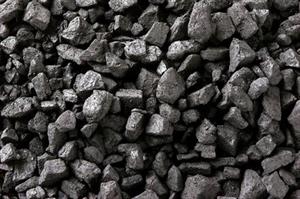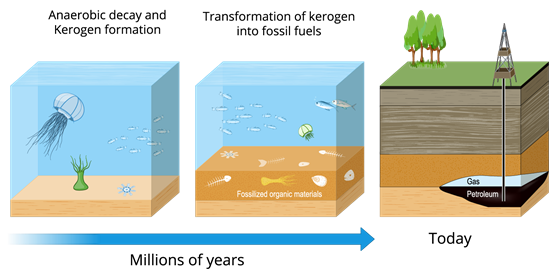
PUMPA - SMART LEARNING
எங்கள் ஆசிரியர்களுடன் 1-ஆன்-1 ஆலோசனை நேரத்தைப் பெறுங்கள். டாப்பர் ஆவதற்கு நாங்கள் பயிற்சி அளிப்போம்
Book Free DemoEver since the industrial revolution, we have been using increasing amounts of energy to meet our basic requirements and manufacture of a variety of goods upon which our lives rely. Fossil fuels have largely met these energy needs. The combustion of fossil fuels meets over \(85\%\) of our energy demands. There are \(three\) types of fossil fuels used for providing energy, including coal, petroleum, and natural gas.
What are fossil fuels?
Fossil fuels are a source of non-renewable energy resource. Fossil fuels are found deep inside the earth's crust, which are energy-rich substances created over millions of years by natural processes such as the anaerobic decomposition of buried dead animals. The remains of the organisms are progressively converted into hydrocarbons, such as petroleum, coal, and natural gas, as the accumulating sediment layers produce heat and pressure.
Coal and petroleum:
Coal and petroleum are natural resources, termed fossil fuels, formed from the degradation or decomposition of biomass buried deep beneath the earth millions of years ago. Coal is a hard, black-coloured rock-like substance of carbon, hydrogen, oxygen, nitrogen, and sulphur.

Coal
Petroleum has been formed from plant and animal remains and is found in sedimentary rocks as mineral oil. Petroleum, commonly known as crude oil, is processed into petrol and diesel in oil refineries.

Formation of petroleum
If we continue to use coal and petroleum at such a fast pace, they will be exhausted. Coal and petroleum will be exhausted in the future, no matter how carefully we use them, as creating these fossil fuels is a very slow process, which takes a long time to renew. Thus, we need to look for alternative sources of energy.
Pollution caused due to burning of coal and petroleum:
a. When fossil fuels are burnt, carbon dioxide, water, nitrogen oxides, and sulphur oxides are produced. If incomplete combustion occurs in an insufficient supply of air (oxygen), then carbon monoxide is generated instead of carbon dioxide. The oxides of nitrogen, sulphur, and carbon monoxide are poisonous at high concentrations.
b. Sulphur dioxide causes respiratory problems. It also dissolves in rainwater, turning it acidic, and causes damage to plants, buildings, monuments, and metal structures.
c. Carbon dioxide causes global warming by acting as a greenhouse gas.
d. Carbon monoxide is a poisonous gas that enters our bloodstream, binds to RBCs, and causes suffocation. Excess carbon monoxide can cause death.
Steps to conserve coal and petroleum resources:
Coal and petroleum resources must be conserved or saved for future use, which can be accomplished by limiting their usage. The following are the ways through which we can conserve coal and petroleum resources:
1. Saving electricity, in turn, reduces the usage of coal.
2. Using bicycles or public transportation like buses instead of cars, scooters, or motorbikes for short distances will reduce the use of coal.
3. Taking the stairs instead of using lifts will reduce the use of coal.
4. Using a pressure cookerreduces the consumption of kerosene and LPG. Wherever possible, solar cookers and solar heaters can be used.
5. Automobiles must be designed with fuel-efficient engines to improve efficiency and to reduce air pollution.
6. Alternative energy sources such as solar energy, hydroelectric energy, wind energy, and biomass energy should be used.
Reference:
https://commons.wikimedia.org/wiki/File:CSIRO_ScienceImage_10945_Coal.jpg